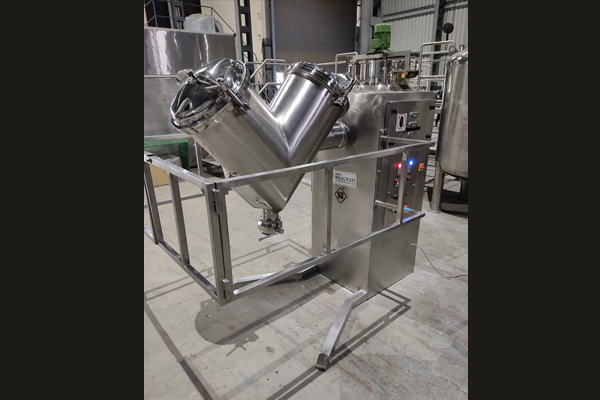WORKING
The V-Blender is a popular tumble blender commonly used in the pharmaceutical and food industries. This article explains the design, construction, and operation of the standard V-Blender and the V-Blender with intensifier bar. The advantages and the disadvantages of the V-Blender are highlighted.
The charging of material into the V-Blender is through either of the two ends or through the apex port. Studies on V-blenders have demonstrated that for solid powders which have similar size and shape, there is no mechanism to move the powders across the line of symmetry of the blender. For such materials, care must then be taken to load each side of the blender equally to ensure the desired homogeneity of blends.
Blending efficiency is affected by the volume of the material loaded into the blender. The recommended fill-up volume for the V-Blender is 50 to 60% of the total blender volume. For example, if the fill of material in the blender is increased from 50% of the total volume to 70% of the total volume, the time taken for homogenous blending may be doubled.
Blender speed may also be a key to mixing efficiency. At lower blender speeds, the shear forces are low. Though higher blending speeds provide more shear, it can lead to greater dusting resulting in segregation of fines. This means that the fines become air-borne and settle on top of the powder bed once the blender has been stopped. There is also a critical speed which, if approached will diminish blending efficiency considerably. As the revolutions per minute increase, the centrifugal forces at the extreme points of the blender will exceed the gravitation forces required for blending. Consequently the powder shall tend to gravitate to the outer walls of the blender shell. As the size of the blender increases, the rotational speed decreases usually in proportion to the peripheral speed of the blender extreme. V-Blenders are designed to operate at 50% to 80% of the critical speed. Discharge from the V-blender is normally through the apex port which is fitted with a discharge valve.
CONSTRUCTION
V-Blender can be provided with high-speed intensifier bars (or lump breakers) running through trunnions into the vessel, along with spray pipes for liquid addition. The intensifiers may be provided for disintegration of agglomerates in the charge material or those formed during wet mixing. Figure 2 is a schematic drawing of the V-Blender with the intensifier bar.
V-cone blender, or twin-shell blender, is a popular mixing device commonly used in China for blending dry powders and granules. It's constructed from two hollow cylindrical shells joined at an angle (typically 75-90 degrees). These shells are mounted on trunnions, allowing the vessel to tumble and tumble, causing the material to split and recombine, achieving a homogeneous mix. The construction often utilizes stainless steel for the inner and outer shells, ensuring durability and hygienic standards.
Provision of the intensifier bars makes the V-Blender adaptable for more applications. These include :
» Ability to accomplish dry as well as wet mixing.
» Suitability for mixing of fine as well as course particle compositions.
» Suitability for mixing of cohesive powders.
Provision of intensifier bars may have the following disadvantages :
» Undesired particle attrition.
» Intensifier bar shaft sealing problems.
» Cleaning problems.
CHARGING /DISCHARGE
The circular opening is provided with a S.S.316 butterfly valve and a conical adapter to facilitate clamping of the charging drum to the blender. The valve can be operated from the ground level with the charging drum in the raised position with the help of a mechanical remotely operated arrangement.
VESSEL DESIGN
» The V-shaped vessel, composed of two interconnected cylinders, is designed to maximize the movement and mixing of materials.
» The blender features two V-shaped cylinders, asymmetric in height, that are welded together at an angle (75-90 degrees). This asymmetric design aids in mixing and facilitates material removal.
TUMBLING MOTION
The rotational motion of the vessel induces a tumbling effect, causing the material to move back and forth, split, and recombine. The V-shaped vessel is mounted on trunnions that allow it to rotate, causing the materials to tumble and mix via diffusion.
MIXING ACTION
As the material tumbles, it undergoes continuous separation and recombination, leading to a thorough and uniform blend.
BLNDING TIME
The blending process typically takes between 5 and 15 minutes, depending on the material being mixed.
ADVANTAGE
V cone blenders are known for their efficiency, uniformity of blending, and suitability for a variety of materials like powders, granules, and pellets. They are also relatively easy to clean and maintain.
MATERIALS
cone blenders in China are typically made of stainless steel (304 or 316L), often with mirror-polished surfaces for easy cleaning and hygiene.
ADVANTAGE OF V-BLENDER
HIGH EFFICIENCY :
V-cone blenders are known for their efficient mixing, often achieving a uniform blend in relatively short timeframes.
MINIMAL DISTORTION :
The absence of blades or agitators within the chamber minimizes any potential distortion or damage to the materials being mixed.
CLOSED SYSTEM :
The enclosed V-chamber and optional safety barriers prevent contamination and ensure safe operation.
VERSATILE APPLICATIONS :
V-cone blenders are suitable for a wide range of dry powders and granules, including pharmaceutical ingredients, food additives, chemicals, and more.
EASY CLEANING :
The smooth, often stainless steel, surfaces of the V-chamber and other components facilitate easy cleaning and maintenance.
LAB AND PRODUCTION SCALE :
V-cone blenders are available in various sizes, ranging from lab-scale models to large-scale production units.
